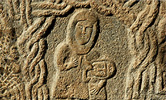1. Brentjes B. Armenian Tombstones and Turkish Adaptations in the 14th, 15th and 16th Centuries - Fifth International Symposium of Armenian Art, Venezia, San Lazaro, 1988, p.159-162.
2. Dalton O. M. British Museum. A Guide to the Early Christian and Byzantine Antiquities in the Department of British and Medieval Antiquities, London, 1903.
3. Der Nersessian S. Armenian Art, Paris, 1978.
4. Gough M. The Origins of Christian Art, London, 1973.
5. Ferguson G. Signs and Symbols in Christian Art, London, Oxford, New York, 1989.
6. Harbison P. Irish High Crosses with the Figure Sculptures Explained, Drogheda, 1994.
7. Hutter I. Early Christian and Buzantine, London, 1988.
8. Petrosyan H. The Khachkar or Cross-Stone - In: Armenian Folk Arts, Culture and Identity /Ed. by L. Abrahamian and N. Sweezy, Bloomington and Indianapolis, 2001, p. 60-70.
9. Petrosyan H. The Sacred Mountain - In: Armenian Folk Arts, Culture and Identity, p. 33-39.
10. Petrosyan H. The Temple. - In: Armenian Folk Arts, Culture and Identity, p. 44-51.
11. Petrosyan H. The World as a Garden - In: Armenian Folk Arts, Culture and Identity, p. 25-32.
12. Petrosyan H. Writing and the Book - In: Armenian Folk Arts, Culture and Identity, p. 52-59.
13. Richardson H. The Jewelled Cross and its Canopy - From the Isles of the North. Early medieval Art Ireland and Britain, Belfast, 1994, p. 177-186.
14. Schiller G. Iconography of Christian Art. London, vol. 2, 1972.
15. Strzygowski G. Die Baukunst des Armenie und Europa, Wien, 1918, bd. 1.
16. Van Loo K. Zur ikonographie armenischen Kreuzsteines - Armenien Wiederentdeekung einer alten Kulturandschaft, Bochum, 1995, s. 115-117. |









